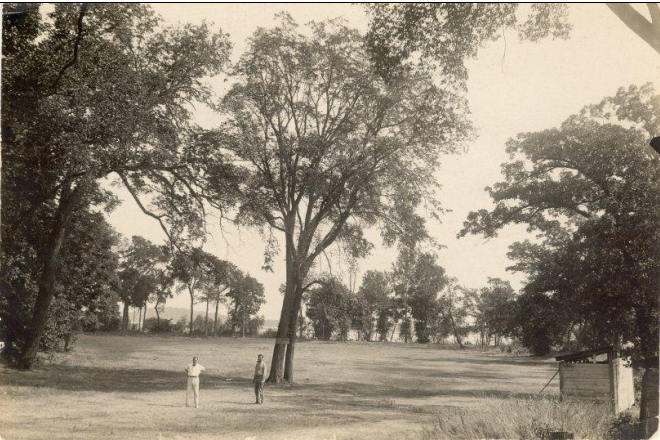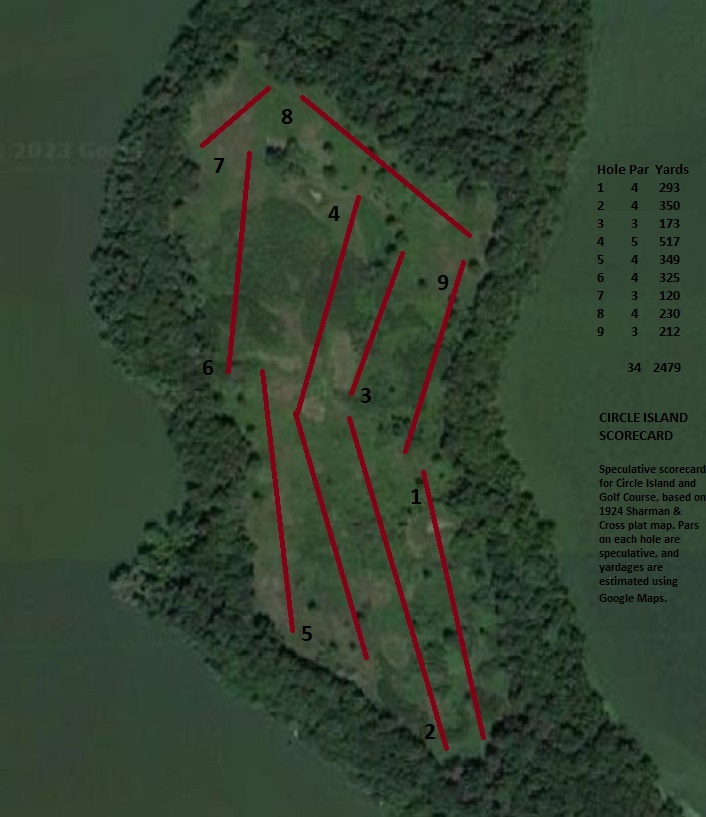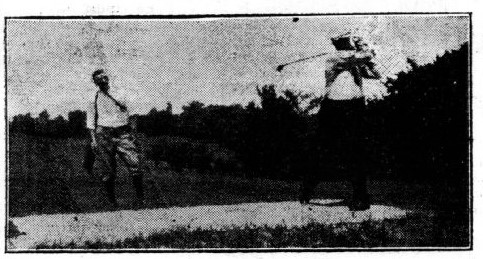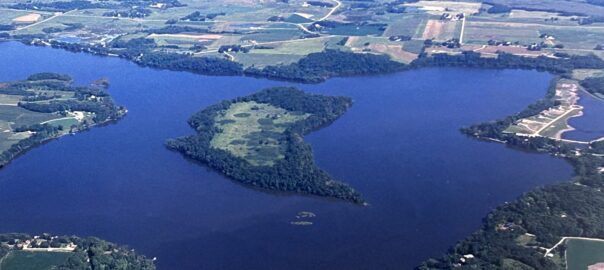Note to readers: This is a slightly altered version of a story I wrote for the 2024 Directory issue of Minnesota Golfer Magazine. It includes some previously unpublished information and photos. Thanks to the Minnesota Golf Association for offering a print venue. Also, this is my first post in about a year, as my website had stopped operating properly. It is back in action, albeit with some gllitches that I can’t fix, plus the caveat that I don’t know how long it’ll remain operational.
Main image: Circle Island, Rice County, 1980s photo courtesy of Shawn Nugent.
Minnesota’s 600-plus golf courses, past and present, have taken up residence just about everywhere: mounted on hilltops, perched alongside lakes, rooted next to rivers, cozied up to cul de sacs, flanked by forests, put out to pastures and deserted on islands.
Wait, what? Say that last part again.
A Minnesota golf course on an island? It’s unheard of.
Yep, pretty much.
Other places have golf courses on islands. Great Britain rules, with more than 3,000 existing courses in England, Scotland and Wales. New York’s Long Island reportedly has more than 140, many of them famed. On Mackinac Island in Michigan, four courses. Anchored next door to us, Wisconsin’s island courses include the Robert Trent Jones-designed and double-greened Madeline Island Golf Club in La Pointe.
But in 130 years of organized Minnesota golf, in a state that accommodates 10K lakes and more, the all-time count of island courses appears to be a mere two, both born exactly a century ago and both long gone. Except for their staging sites, neither course was remarkable. But hey, they had that surrounded-by-water thing going for them.
CONEY ISLE
On a crisp September morning in 2023, a boatful of a dozen curiosity-seekers set off from shore at Lake Waconia Regional Park, their destination a mile away, a landing near the southwestern tip of Coney Island of the West (theories vary as to the origin of the name; it also was known as Paradise Island in the early 1900s). The 31-acre island as a whole was the excursion’s main attraction; only one visitor had a particular interest in what once lay near its eastern shore. (This is called fore-shadowing, please excuse the pun.)
It’s a fascinating place, beyond its thick woods, winding trails and the inviting backdrop of the city of Waconia, prominently in view a half-mile away. Listed on the National Register of Historic Places, Coney Island of the West holds archeological and historical significance.
Indigenous people visited the island for centuries before it was settled by those of European descent, and relics continue to be found there. Lambert Naegele bought the island in 1884, platted it with streets named after German authors such as Goethe, and built a large hotel. The land was platted and sold. Private cabins were built on the lots.
Reinhold Zeglin and sons operated the island resort before the turn of the 20th century. The Zeglins’ interests included sports; they built a bowling alley, added croquet grounds and hosted the University of Minnesota football team, coached by Gilmore Dobie, for preseason training from 1903 to 1905. Workouts were held on a small, flat, open patch on the eastern end of the island.
“Better spot could not be found if the world was raked with a fine-toothed comb,” the Minneapolis Journal declared of Coney Island in August 1904.
Two decades later, J.W. Zeglin invited sportsmen of a different bent to play a burgeoning game on the grounds.
“Coney Isle Hotel / Open season May 1924 on May 29th,” began an ad in the Minneapolis Tribune. “Under same management for 36 years.”
The kicker followed, no football reference intended …
“Five-hole golf course.”

Coney Island lay 30 miles southwest of Minneapolis. A round trip by rail could be secured for $1.50, the ad said. Room and board would cost $3.50 to $4.50 per day, with “splendid Sunday dinner” for $1.00.
Guests were ferried to and from the island. Zeglin would attract up to 1,000 visitors for events, it is said, so it’s no wonder he might have considered a golf course a worthwhile side attraction.
But could it really be considered a golf course?
Wendy Petersen Biorn, executive director of the Carver County Historical Society, had heard of reports about golf on Coney Isle but had expressed skepticism about the bona fides. The boat trip illustrated why.
The former “golf course” is the size of a football field, not coincidentally, and not much more. It’s reasonable to imagine a longest hole of about 130 yards, a couple more of 75 to 80, and one or two others that would be no more than pitch-and-putt. That’s if you stretch it.
Zeglin spread word of his golf course south. In addition to Minneapolis papers, Coney Island was advertised in newspapers in Kansas City, Omaha and Bartlesville, Okla. The latter’s ad inexplicably said the isle was 130 miles from the Twin Cities. An Omaha Evening World-Herald ad boasted, “The individual service, the atmosphere of refinement and the ideal location of this summer resort have put it in a class by itself for real merit.”
But as a golf course, Coney Isle was small potatoes – and shrinking ones at that.
After the five-hole reference in 1924, a Minneapolis Journal story in 1925 referred to “a four-hole golf course, located on the island.” And then in 1928, a Journal description had reduced the grounds to a “four-hole putting course.”
That was the last reference I could find to golf on Coney Island.
The island’s popularity had peaked before that, and even though a dance hall, restaurant and more cabins were added starting in 1940, everything was left to deteriorate starting in 1958. Vandalism contributed to further degeneration until efforts to revitalize began in 1975. Today, Carver County continues work, with picnic grounds, trails, beaches and a boat launch, and plans to improve the island even further.
As for golf, one tangential connection remains. A mile and a quarter across Lake Waconia lies a real, complete, functioning course — Island View Golf Club, the Minnesota Golf Association’s 2023 Member Club of the Year, from where Coney Island can be seen across the water.
CIRCLE ISLAND and GOLF COURSE
In the exact months J.W. Zeglin was starting something small on one island, Graham Sharman was planning something very big on another.
Sharman was president of Sharman & Cross, a Minneapolis real estate brokerage and investment firm in the 1920s. On March 5, 1924, the Faribault Journal ran a story headlined “WILL ESTABLISH BIG RESORT.”
The story began: “The firm of Sharman & Cross, of Minneapolis, have announced that they will construct a S1OO,OOO summer resort in Rice county this year, work to begin just as soon as the frost is out of the ground. …”
Culling from newspaper accounts, the project’s stated features would include a hotel, cabins, playground, tennis courts, concert pavilion, waterslide, boathouse, ferries and — the centerpiece — an 18-hole island golf course.
“… Rice county,” the Journal story stated, “is assured of the finest summer resort in Southern Minnesota.”
We shall see.
Weeks earlier, Caroline Dulac had for $40,000 sold 130 acres of property that had been in her family since the previous century. The tract, near the center of Rice County, consisted of a 100-acre island on Circle Lake and 30 acres adjoining its eastern shore.
Circle Lake, not particularly circle-shaped but whatever, lies eight miles north of Faribault, nine miles southwest of Northfield and 40 miles south of downtown Minneapolis. As golf’s popularity boomed in the early 1920s, Sharman no doubt considered his market demographics and seized on an opportunity.
Sharman and business partner Thomas Cross promoted their project with ads in Minneapolis and Faribault newspapers, and composed large, detailed announcements touting the newly named Circle Island and Golf Course. The copy writers heaped on hyperbole and breached a border into bombast.
“Fore!!!” blared one ad featuring a map showing Circle Lake and its proximity to Minnesota cities.
“A frolicking swim in the sparkling water on your own sandy beach. … An hour’s boating with gamey fish beneath, daring you to drop your line. … Back to rest under your own maples or to stroll in the woods, but wait — A hundred steps away — the Golf Course — YOUR Golf Course. Oh Boy! Perhaps a hole in one, at least a birdie; anyway it’s a grand old game.”
Sharman and friends consistently made claims that were outlandish or perilously close to it. Principally, suggestions of an 18-hole course were half-baked. The island didn’t have nearly enough room for 18 palatable holes, not to mention room to also accommodate the 249 small residential lots, most of them 50 by 150 feet, that were platted around the island’s perimiter.
Yet there was room for golf. Work on a course, scaled down to nine holes, began in mid-April 1924. “A well known golf course architect has the course under construction,” a Sharman & Cross ad read in part. “The course covers the center of the island and has been pronounced the best natural course in the Midwest.” (My research never turned up a name associated with the design, though over the exact same months Northfield Golf Club, designed by William Clark, architect of Twin Cities public courses and many others, was being built 10 miles away.)
The Circle Island routing looks legit. Using Google maps and an ad that showed tees and greens, hole lengths can be estimated. The course likely measured close to 2,500 yards. The first hole, accessed after a ferry ride, would have progressed southward about 293 yards. Second hole, north to the center of the island, about 350 yards. The fourth was probably the longest, close to 500 yards, likely a dogleg. No. 7 was the shortest, at the northwest corner of the island and measuring about 120 yards.

Speculative routing and scorecard for Circle Island Golf Course. (My digital artistic publishing skills are primitive at best, you’ll notice, and I hope this is at least marginally readable.)
Circle Island Golf Course featured no holes alongside Circle Lake. Lots bordering the course were wooded, creating what one modern-day observer calls a “reverse links” effect: The trees stood as a link between the lakeshore and the higher ground above, which had been clear-cut decades before.
The course opened before summer broke in 1924. There was scant newspaper coverage of golf, but there were sporadic reports on events at the “resort” (sans hotel, cottages and more). A Theopold-Reid Co. picnic drew more than 100 visitors, and a Faribault Weekly Journal photo showed company president H.C. Theopold following through on a drive at the golf course. A Farm Bureau picnic that doubled as an opening ceremony for the development drew 7,500, the Minneapolis Journal reported, and a team from Faribault defeated one from Northfield in the first competition at the course.

Sharman in March 1924 had said it would take two to three years for the resort to be completed. A century later, it still isn’t completed, and it was barely ever started. A dance pavilion on the “mainland” 30 acres was built and proved popular, with entertainment by the likes of the Dixie Dance Demons, before burning down in 1938. The island, meanwhile, lay almost untouched except for nine greens and nine concrete golf cups, one of which was discovered by Shawn Nugent, who owned the island in the late 1980s and now operates a business on Circle Lake’s eastern shore.
Despite reports of thousands of visitors to the resort, it’s a mystery as to whether Graham Sharman ever persuaded a client to purchase an island lot. Dennis Henry, a retired Gustavus Adolphus physics professor, spent a few summers in the 1950s helping farm the island with his uncle Herb Younker, who owned it. Duties included ferrying cattle across the lake. Henry’s recollection was that there was only one building on the island, a tiled house with poured concrete floors. He remembered airplanes landing on the island, and “it was amazing how little the trees had encroached on the area.” Nugent said an old foundation and well casing exists on the southern half of the island. He said the island is largely overgrown now. It is principally owned by a Prior Lake party and for a time in late 2023 was listed on Internet sites as being for sale, with an asking price of $1,030,000.
The Circle Island Golf mystery is further complicated by how long — or the opposite — the course operated. A 1958 paper held by the Rice County Historical Society declared that “during the depression, the resort quieted to nothing.” A 1999 newspaper story was headlined “Depression kills island course,” but offered no supporting evidence of the timeline.
It’s more likely the course was abandoned before 1930. A Faribault News ad from 1926 promoted a three-day Fourth of July celebration, including golf, but after that … nothing. Dozens of searches and microfilm scans of newspapers from 1927-1930 produced no evidence the course was still in play. Sharman & Cross is last listed as a business in the 1926 Minneapolis city directory, and by 1927, both principals were listed as salesmen for Minneapolis bond broker John C. Kuck & Co.
Whether the demise of the Circle Island project qualifies as tragedy is arguable. After all, close to 250 other Minnesota golf courses have similarly been abandoned. As for actual tragedy …
Henry remembered that one summer, an independent-minded steer was among cattle ferried to the island for summer vacation. It made a break for freedom by starting a swim back to the mainland. “That steer had been a problem,” Henry said.
A phone call from a neighbor on the mainland followed. You’d better come get your steer, the neighbor said, because it’s floating in the lake, belly up.
It had been struck by lightning and killed.
When it was suggested the steer deserved credit for ingenuity, Henry retorted, “It got its come-uppance.”
Sources for this story include the Carver and Rice County historical societies, and MNOpedia.org.
CIRCLE ISLAND POSTSCRIPTS
— The Faribault Journal in April 1924 reported that E.A. Dunlop had been appointed manager of “the new summer resort” at Circle Lake. His duties were to include “laying out of golf course, tennis courts and other recreational features.” I researched but could find no mention of a Dunlop significantly associated with Minnesota golf (no, tying it to the golf manufacturing giant does not count).
— Robert Palmquist, who lives on Circle Lake’s north shoreline, passed along some nuggets via email. He said an old road, about 5 to 6 feet wide, led from the eastern lakeshore to the golf course area. He surmised that’s where the golf course clubhouse would have been. I don’t think a clubhouse ever was built, but it makes sense that the road led to where one might have been – near the first tee of the golf course.
— Palmquist noted where the foundations of an old building are located, near the southeast corner of the island. :I was told by old-timers that it was a granary for feeding cattle that were left to roam on the island during the summers,” Palmquist wrote. “It was also where two people took refuge during the Armistice Day Blizzard in 1940 when their small boat capsized and they were stranded on the island for the night -– they buried themselves in the grain to keep warm.”
“In 2000,” Palmquist wrote, “there was a very brief effort to restart the golf course. 9 holes on the island and 9 holes to the north on a property now called ‘Maple Shores.’ The idea was homes would be built around nine holes in the Maple Shores portion, and a pontoon boat would ferry people to the island for the ‘back nine’ of the course.” The proposal never went beyond discussion, Palmquist wrote.
More photos on both courses will be published on a separate post.
Latest posts by Joe Bissen (see all)
- Another lost routing: Hilltop, Columbia Heights - June 19, 2024
- Two lost routes: First, Antlers Park - June 17, 2024
- Tree trouble and townball: Naeseth Country Club, Wanamingo - May 6, 2024
